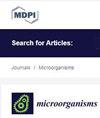用于检测环境样本中军团菌的生物传感技术:系统综述
IF 4.1
2区 生物学
Q2 MICROBIOLOGY
引用次数: 0
摘要
检测水等环境样本中的军团菌对公共卫生监测和疫情预防至关重要。传统的检测方法(包括基于培养的技术和聚合酶链反应)虽然有效,但也有其局限性,如处理时间长、操作人员需经过培训、需要专门的实验室设备等。生物传感技术具有快速、灵敏、成本效益高和现场检测能力强等特点,是一种很有前途的替代方法。为了总结当前用于检测环境样本中军团菌的生物传感器开发进展,我们使用 "军团菌 "和 "生物传感器"(近似 "环境样本 "或 "水")作为关键词,在最相关的生物医学数据库中搜索研究文章。在使用 PRISMA 方法排除标准从 1268 条记录中剔除重复和不充分的文章后,我们选择了 65 篇符合纳入标准的全文文章。在介绍当前生物传感技术(包括光学传感器、电化学传感器、磁传感器和质敏传感器)的研究中,我们观察到了不同的结果。对每种生物传感技术的灵敏度、特异性和检测限进行了评估。此外,还讨论了纳米材料、微流体技术和便携式设备在生物传感器系统设计中的整合,强调了它们在提高检测性能方面的作用。会议还讨论了军团菌生物传感领域的潜在挑战和未来发展方向,深入探讨了在常规环境监测中采用这些技术的可行性。毫无疑问,生物传感器可以在军团菌感染和爆发的早期检测和管理中发挥关键作用,最终保护公众健康和安全。本文章由计算机程序翻译,如有差异,请以英文原文为准。
Biosensing Technologies for Detecting Legionella in Environmental Samples: A Systematic Review
The detection of Legionella in environmental samples, such as water, is crucial for public health monitoring and outbreak prevention. Although effective, traditional detection methods, including culture-based techniques and polymerase chain reaction, have limitations such as long processing times, trained operators, and the need for specialized laboratory equipment. Biosensing technologies offer a promising alternative due to their rapid, sensitive, cost-effectiveness, and on-site detection capabilities. To summarize the current advancements in biosensor development for detecting Legionella in environmental samples, we used ‘Legionella’ AND ‘biosensors’ NEAR ‘environmental samples’ OR ‘water’ as keywords searching through the most relevant biomedical databases for research articles. After removing duplicates and inadequate articles from the n. 1268 records identified using the PRISMA methodology exclusion criteria, we selected n. 65 full-text articles which suited the inclusion criteria. Different results between the studies describing the current biosensing techniques, including optical, electrochemical, magnetic, and mass-sensitive sensors were observed. For each biosensing technique, sensitivity, specificity, and detection limits were evaluated. Furthermore, the integration of nanomaterials, microfluidics, and portable devices in biosensor systems’ design were discussed, highlighting their role in enhancing detection performance. The potential challenges and future directions in the field of Legionella biosensing were also addressed, providing insights into the feasibility of implementing these technologies in routine environmental monitoring. Undoubtedly, biosensors can play a crucial role in the early detection and management of Legionella infections and outbreaks, ultimately protecting public health and safety.
求助全文
通过发布文献求助,成功后即可免费获取论文全文。
去求助
来源期刊

Microorganisms
Medicine-Microbiology (medical)
CiteScore
7.40
自引率
6.70%
发文量
2168
审稿时长
20.03 days
期刊介绍:
Microorganisms (ISSN 2076-2607) is an international, peer-reviewed open access journal which provides an advanced forum for studies related to prokaryotic and eukaryotic microorganisms, viruses and prions. It publishes reviews, research papers and communications. Our aim is to encourage scientists to publish their experimental and theoretical results in as much detail as possible. There is no restriction on the length of the papers. The full experimental details must be provided so that the results can be reproduced. Electronic files and software regarding the full details of the calculation or experimental procedure, if unable to be published in a normal way, can be deposited as supplementary electronic material.
 求助内容:
求助内容: 应助结果提醒方式:
应助结果提醒方式:


